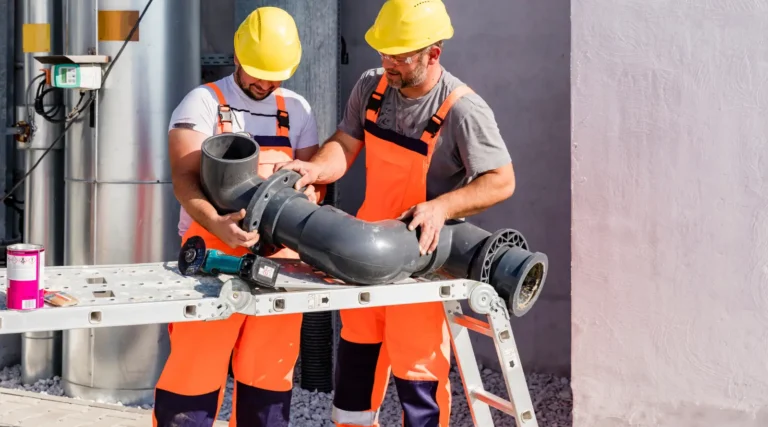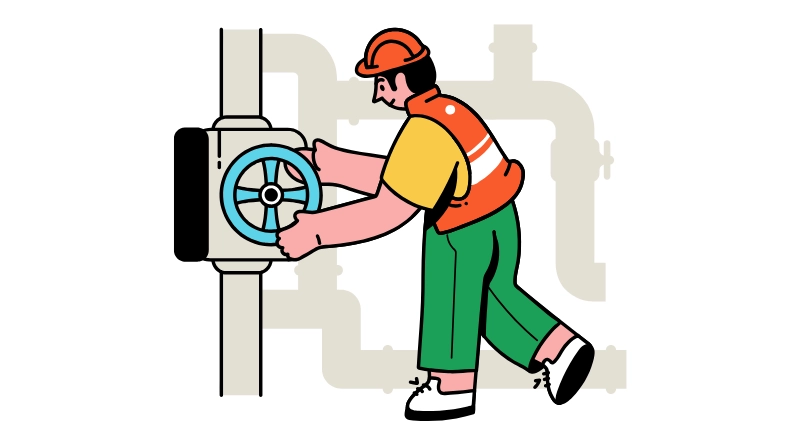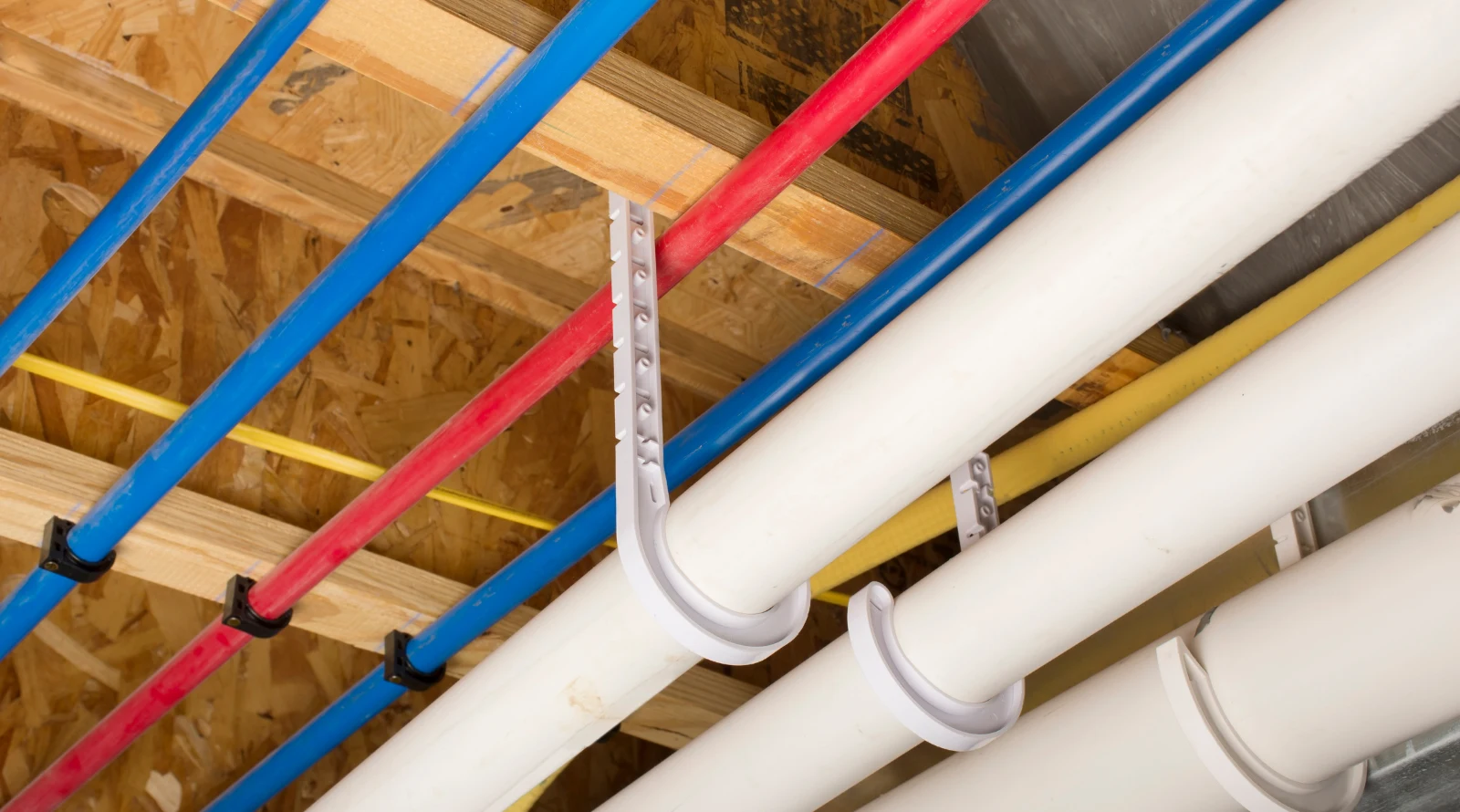Curious about how pipes are sized? Pipe sizes might seem puzzling, but they’re vital to understand, especially in plumbing and construction.

Whether you’re dealing with Copper, HDPE, PEX, or Steel Pipes, knowing their sizes is key. In this easy-to-follow guide, we’ll walk through measuring pipe sizes step by step. We’ll also provide simple charts for copper pipe sizes, HDPE pipe sizes, PEX pipe sizes, and even a chart for pipe thread sizes.
Plus, we’ll uncover why steel pipe sizes matter and introduce a helpful pipe size calculator. By the end, you’ll feel confident navigating different pipe dimensions for any project you tackle!
Exploring Various Pipe Materials and Sizes
Pipes are like the superheroes of our homes and buildings, helping liquids and gases flow smoothly. But did you know that choosing the right pipe material and size is super important for things to work well? Let’s dive into the basics of different pipe materials and sizes.
Types of Pipes
1. PVC (Polyvinyl Chloride)
- What’s Good: It’s cheap, light, and doesn’t rust.
- Things to Remember: Don’t use it where it gets really hot, and keep it away from too much sunlight.
2. Copper
- Why People Like It: It lasts a long time, doesn’t rust, and works both inside and outside.
- What to Keep in Mind: It can be a bit expensive, and the price can change.
3. Galvanized Steel
- Strong Points: Tough and good for outside use.
- Watch Out: It can rust on the inside over time.
4. PEX (Cross-linked Polyethylene)
- Cool Features: It’s bendy, easy to put in, and doesn’t mind chlorine.
- Things to Think About: Some worry about how long it lasts in certain conditions.
5. Stainless Steel
- Why It’s Great: Super strong, doesn’t rust, and can handle high heat.
- Keep in Mind: It costs more at first, but it stays good for a long time.
Copper Pipe Size Chart
Copper pipes are essential components in plumbing, HVAC systems, and various industrial applications due to their durability, corrosion resistance, and excellent heat conductivity. Understanding copper pipe sizes will ensure proper flow, efficiency, and compatibility within different systems.
| Nominal Size (Inches) | Outside Diameter (Inches) | Inside Diameter (Inches) | Wall Thickness (Inches) |
|---|---|---|---|
| 1/4 | 0.375 | 0.305 | 0.035 |
| 3/8 | 0.5 | 0.402 | 0.049 |
| 1/2 | 0.625 | 0.527 | 0.049 |
| 3/4 | 0.875 | 0.745 | 0.065 |
| 1 | 1.125 | 0.995 | 0.065 |
| 1 1/4 | 1.375 | 1.245 | 0.065 |
| 1 1/2 | 1.625 | 1.481 | 0.072 |
| 2 | 2.125 | 1.959 | 0.083 |
| 2 1/2 | 2.625 | 2.435 | 0.095 |
| 3 | 3.125 | 2.907 | 0.109 |
| 4 | 4.125 | 3.785 | 0.170 |
Applications of Different Copper Pipe Sizes –
- Residential Plumbing: Smaller sizes like 1/2 inch and 3/4 inch are commonly used for residential plumbing systems, supplying water to sinks, showers, and appliances.
- HVAC Systems: Larger sizes such as 1 inch to 4 inches are utilized in HVAC systems for refrigerant lines, condensate drain pipes, and supply/return lines.
- Industrial Applications: In industrial settings, various sizes are employed based on the specific needs of processes, including transporting fluids, chemicals, and gases.
- Fire Sprinkler Systems: 3/4 inch to 2 inches pipes are typical in fire sprinkler installations due to their reliability and durability.
HDPE Pipe Sizes
When it comes to piping systems, High-Density Polyethylene (HDPE) has emerged as a versatile and durable material. One crucial aspect influencing its functionality is the range of sizes available. HDPE pipe sizes play a pivotal role in various industries, affecting everything from fluid transportation to infrastructure development.
Here’s a table that can tell you about different HDPE Pipe Sizes:
| Nominal Diameter (inches) | Outside Diameter – OD (inches) | Wall Thickness – WT (inches) | Pressure Rating (PSI) |
|---|---|---|---|
| 1/2 | 0.840 | 0.109 | 200 |
| 3/4 | 1.050 | 0.113 | 200 |
| 1 | 1.315 | 0.133 | 200 |
| 1-1/4 | 1.660 | 0.140 | 200 |
| 1-1/2 | 1.900 | 0.145 | 200 |
| 2 | 2.375 | 0.154 | 200 |
| 2-1/2 | 2.875 | 0.203 | 200 |
| 3 | 3.500 | 0.216 | 200 |
| 4 | 4.500 | 0.237 | 200 |
| 6 | 6.625 | 0.280 | 200 |
| 8 | 8.625 | 0.322 | 200 |
| 10 | 10.750 | 0.365 | 200 |
| 12 | 12.750 | 0.406 | 200 |
| 14 | 14.000 | 0.437 | 200 |
| 16 | 16.000 | 0.500 | 200 |
| 18 | 18.000 | 0.562 | 200 |
| 20 | 20.000 | 0.625 | 200 |
| 24 | 24.000 | 0.687 | 200 |
| 30 | 30.000 | 0.812 | 200 |
| 36 | 36.000 | 0.937 | 200 |
These specifications provide a comprehensive overview of HDPE pipe sizes commonly available in the market, including nominal diameters, corresponding outside diameters, wall thicknesses, and pressure ratings.
This detailed table may help you in the precise selection of HDPE pipes according to specific project requirements and application needs.
Applications of Different HDPE Pipe Sizes –
- Small Bore Pipes (1/2 inch – 4 inches): Often used in residential plumbing, irrigation systems, and small-scale industrial applications.
- Medium Diameter Pipes (6 inches – 16 inches): Ideal for municipal water distribution networks, wastewater management, and industrial fluid transportation.
- Large Diameter Pipes (18 inches and above): Commonly employed in major infrastructure projects such as stormwater management, mining, and marine applications.
PEX Pipe Sizes
PEX (cross-linked polyethylene) pipes have gained immense popularity in plumbing systems due to their flexibility, durability, and ease of installation. However, navigating the various sizes available can be overwhelming. So look at the table below for some guidance:
| PEX Size | Nominal Diameter (inches) | Outer Diameter (inches) | Inner Diameter (inches) | Recommended Applications |
|---|---|---|---|---|
| 3/8″ | 0.375 | 0.500 | 0.360 | Small fixtures, ice makers, filtration systems |
| 1/2″ | 0.500 | 0.625 | 0.475 | General household use, faucets, toilets, showers |
| 5/8″ | 0.625 | 0.750 | 0.570 | Larger fixtures, increased flow rates |
| 3/4″ | 0.750 | 0.875 | 0.671 | Main water lines, high-demand applications |
| 1″ | 1.000 | 1.125 | 0.859 | Commercial buildings, high-flow applications |
Pipe Thread Size Chart
Pipe threads are designated by two primary measurements: the nominal pipe size (NPS) and the thread pitch. The NPS refers to the nominal or approximate inside diameter of the pipe, while the pitch determines the number of threads per inch.
| Nominal Pipe Size (NPS) | Thread Pitch (TPI) | Outer Diameter (inches) |
|---|---|---|
| 1/16 | 27 | 0.3125 |
| 1/8 | 27 | 0.405 |
| 1/4 | 18 | 0.540 |
| 3/8 | 18 | 0.675 |
| 1/2 | 14 | 0.840 |
| 3/4 | 14 | 1.050 |
| 1 | 11.5 | 1.315 |
| 1 1/4 | 11.5 | 1.660 |
| 1 1/2 | 11.5 | 1.900 |
| 2 | 11.5 | 2.375 |
| 2 1/2 | 8 | 2.875 |
| 3 | 8 | 3.500 |
| 3 1/2 | 8 | 4.000 |
| 4 | 8 | 4.500 |
| 5 | 8 | 5.563 |
| 6 | 8 | 6.625 |
| 8 | 8 | 8.625 |
| 10 | 8 | 10.750 |
| 12 | 8 | 12.750 |
Applications and Considerations –
- Plumbing Systems: Water supply lines, drainage systems, and irrigation setups often utilize various pipe thread sizes for different sections.
- Industrial Settings: Oil, gas, and chemical industries rely on accurate thread sizing for efficient fluid transportation and containment.
- Mechanical Engineering: Threaded pipes are integral in mechanical systems, including HVAC installations and machinery.
Steel Pipe Sizes
Steel pipes come in a variety of sizes, categorized based on nominal pipe size (NPS) and pipe schedules. NPS refers to the nominal bore size, while schedules denote the wall thickness. Common NPS sizes range from 1/8 inch to 72 inches or more, with varying schedules (thickness) denoted by schedules such as SCH 5, SCH 10, SCH 40, etc.
Here’s an overview of standard steel pipe sizes:
| Nominal Pipe Size (NPS) | Outside Diameter (OD) in inches | Schedule (Wall Thickness in inches) |
|---|---|---|
| 1/8 | 0.405 | 10, 40, 80, 160 |
| 1/4 | 0.540 | 10, 40, 80 |
| 3/8 | 0.675 | 10, 40, 80 |
| 1/2 | 0.840 | 10, 40, 80, 160 |
| 3/4 | 1.050 | 10, 40, 80 |
| 1 | 1.315 | 10, 40, 80, 160, XXS |
| 1 1/4 | 1.660 | 10, 40, 80, 160, XXS |
| 1 1/2 | 1.900 | 10, 40, 80, 160, XXS |
| 2 | 2.375 | 10, 40, 80, 160, XXS |
| 2 1/2 | 2.875 | 10, 40, 80, 160 |
| 3 | 3.500 | 10, 40, 80, 160, XXS |
| 3 1/2 | 4.000 | 10, 40, 80 |
| 4 | 4.500 | 10, 40, 80, 160, XXS |
| 5 | 5.563 | 10, 40, 80, 120, 160, XXS |
| 6 | 6.625 | 5, 10, 20, 30, 40, 60, 80, 100, 120 |
| 8 | 8.625 | 5, 10, 20, 30, 40, 60, 80, 100, 120 |
| 10 | 10.750 | 5, 10, 20, 30, 40, 60, 80, 100, 120 |
| 12 | 12.750 | 5, 10, 20, 30, 40, 60, 80, 100, 120 |
| 14 | 14.000 | 5, 10, 20, 30, 40, 60, 80, 100, 120 |
| 16 | 16.000 | 5, 10, 20, 30, 40, 60, 80, 100, 120 |
| 18 | 18.000 | 5, 10, 20, 30, 40, 60, 80, 100 |
| 20 | 20.000 | 5, 10, 20, 30, 40, 60, 80, 100 |
| 24 | 24.000 | 5, 10, 20, 30, 40, 60, 80, 100 |
| 30 | 30.000 | 5, 10, 20, 30, 40, 60, 80, 100 |
| 36 | 36.000 | 5, 10, 20, 30, 40, 60, 80, 100, 120 |
| 48 | 48.000 | 5, 10, 20, 30, 40, 60, 80, 100, 120 |
| 60 | 60.000 | 5, 10, 20, 30, 40, 60, 80, 100 |
| 72 | 72.000 | 10, 20, 30, 40, 60, 80, 100 |
How to Measure Pipe Sizes
To understand the pipe size measurements better, you should know the following terms beforehand:
1. Diameter
The most critical aspect of measuring pipes is determining the diameter. Pipes are commonly measured by their inner diameter (ID) or outer diameter (OD). The inner diameter refers to the distance across the opening of the pipe, while the outer diameter is the distance across the entire pipe.
2. Pipe Schedule
Another factor in determining pipe size is the schedule, which indicates the wall thickness and handling capacity. Common schedules include Schedule 40 and Schedule 80, each designed for specific purposes. The schedule is usually stamped on the pipe or can be measured using a pipe schedule gauge to ensure precise identification.
3. Thread Size
For threaded pipes, understanding the thread size is crucial. This measurement determines the compatibility of fittings. Use a thread gauge to ascertain the number of threads per inch accurately.
RECOMMENDED PLUMBERS FOR THE PIPE FITTING JOB:
Step-by-Step Measurement Process
- Determine the Type of Pipe: Identify whether it’s copper, HDPE, PEX, steel, or another material.
- Outer Diameter (OD): Measure the outer diameter accurately using a measuring tape or caliper for pipes like copper and steel.
- Wall Thickness: Measure the thickness of the pipe’s walls. This step is crucial for accurate fittings and connections.
- Nominal Diameter (DN): For HDPE and PEX pipes, understand the nominal diameter and how it relates to their applications.
- Thread Size: Use a pipe thread size chart to match the fittings and connections with the pipe thread size.
Estimated Pipe Size Calculator
Conclusion
Measuring pipe size accurately is fundamental for successful installations and fittings. Whether it’s copper, HDPE, PEX, steel, or other materials, understanding the nuances of measuring these pipes is vital. Use our comprehensive guide, including a copper pipe size chart, HDPE pipe sizes, PEX pipe sizes, pipe thread size chart, and steel pipe sizes, to navigate the complexities of pipe sizing. Utilize the suggested tools and methodologies to ensure precision in your pipe measurements.
Remember, while the provided calculator offers a basic estimation, consulting with a licensed plumber is always recommended for accurate sizing and compliance with local building codes.
RELATED:
- How to Measure a PVC Pipe Diameter [Size Chart + Calculator]
- High Water Bill With No Visible Leak? – Causes, Detection, Solutions, and Calculator
- Importance of Drain & Sewer Pipe Slope [With Chart & Calculator]
- Shower Tile Installation Cost Online Calculator
- Online Free Plumbing Installation Cost Estimator






